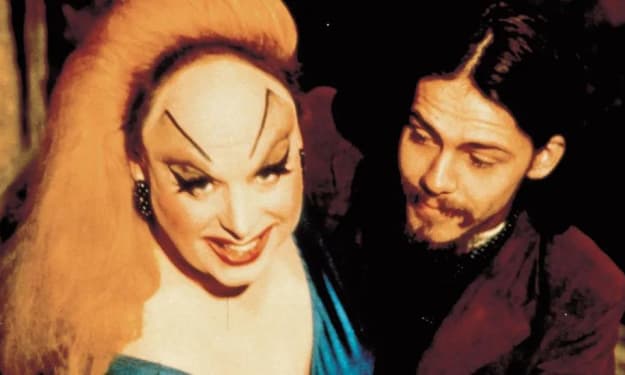The greatest decade in cinema history?
The era that began 100 years ago brought more change and produced more influential films than any other. Luke Buckmaster makes the case for the Roaring Twenties.

Since motion pictures first arrived in the late 19th Century, each new decade has heralded movements and styles that influenced the development of cinema. The 1940s and ‘50s constituted peak periods for US film noir, for example, while the convention-upturning French New Wave blossomed in the 1960s. Both of these genres made a big impact on cinematic storytelling, but which decade tipped the axis of the motion picture medium in the most profound ways?
If we view decades solely in terms of artistic quality, then personal preference, inevitably, comes into play. If film noir is my favourite genre, for example, I am more likely to recognise – or overstate – the significance of the era from which it emanated. If technological and industry-based changes are included as well as artistic output, however, the task is easier and the answers more conclusive. Yet even when several factors are considered, the needle swings towards one decade as a period of unparalleled change: the ‘Roaring Twenties’.
There are several reasons why the decade that began a century ago saw the kind of transformative change that will never come again. They include artistic movements that played a huge role in developing cinematic language, the formation of industry initiatives still hugely influential today, the introduction of perhaps the most significant technical development since the projection of moving images (hint: it involves another sense – the one experienced through your ears), as well as the enduring impact of the films themselves.
Other decades and periods are significant for various reasons. The 1900s, for instance, heralded a period of intense experimentation, as artists played around with film cameras and editing machines for the first time. Fast forward 100 years and the rapid evolution of digital filmmaking that took off in the 2000s, occurring alongside the rise of various internet technologies, was also influential for both production and exhibition. The Guardian critic Peter Bradshaw described the period as “a glorious and revolutionary time for cinephilia”.
But the 1900s marked the embryonic moments of the cinematic medium; a wave of creative trial and error before the dust settled. And the great changes during the 2000s spilled into areas much broader than cinema itself – such as the rise of smartphone cameras, social media videos and online streaming. Plus, the motion pictures made during this period would not have been possible without the foundational developments achieved in films made during the ‘20s.
Sight & Sound’s 2012 critics’ poll placed four titles from the 1920s in its top 15 greatest films of all time – more than any other decade
And what a magnificent slate of productions they are. The 1920s saw, among many others, the arrival of great films such as Sunrise: A Song of Two Humans; Man with a Movie Camera; Metropolis; The Passion of Joan of Arc; Battleship Potemkin; The Cabinet of Doctor Caligari; Nosferatu; Napoleon and some notable works from great comedians Charlie Chaplin and Buster Keaton – such as The Goldrush and The Kid (Chaplin) and The General and Sherlock Jr (Keaton). Sight & Sound’s 2012 critics’ poll placed four of these titles in its top 15 greatest films of all time – the most of any decade.
Many of these films are landmarks for various reasons. The Passion of Joan of Arc boldly embraced the psychologically revealing intensity of the close-up, shot by Danish auteur Carl Theodor Dreyer and his cinematographer Rudolph Maté in extremely close proximity to the actors. Fritz Lang’s epic Metropolis is widely regarded as not just a genre film but a film that created a genre: the futuristic dystopian sci-fi. Dziga Vertov’s experimental documentary Man With a Movie Camera pioneered different ways of thinking about scale and perspective, while German Expressionist classics Nosferatu and The Cabinet of Dr Caligari are notable for their striking lighting and set design – emphasising ways in which a film’s aesthetics can be used psychologically, to create a state of mind. This marked a move away from realism, influencing many filmmakers who became influential themselves – among them Alfred Hitchcock, Orson Welles and Billy Wilder.
If one were to identify a single, most influential sequence from the 1920s, it is difficult to look past the Odessa steps sequence from Sergei Eisenstein’s 1925 film Battleship Potemkin – among the most celebrated and referenced scenes in cinema history. In this electric stretch of celluloid, which is still breathtaking today, the director cuts between highly dramatic images of panicked people running down the steps, as they are massacred by rifle and bayonet-wielding Tsarist soldiers. Taken in isolation, the shots in this sequence mean little. Together, however, they form a rhythmic, hair-raising sequence that played a huge part in developing montage – now considered one of the key foundational techniques in film editing. The way Eisenstein transitions between images brought a power and magnetism to motion pictures that had never been seen before. As critic David Thomson put it in The Guardian: “he dramatised the cut”. Roger Ebert called the film “one of the foundational landmarks of cinema”, while Andrew O’Hehir described Eisenstein’s radical innovations as nothing less than “part of a global shift in mass consciousness”.
Wired for sound
If the 1920s saw the development and fine-tuning of modern filmmaking language, an invention arrived in the second half of the decade that changed everything. In 1927 audiences experienced a brand-new dimension in cinema with the arrival of The Jazz Singer – the very first ‘talkie’. Starring the popular entertainer Al Jolson, the film – which featured spoken dialogue, musical scenes and a recorded score – heralded the dawn of synchronised sound in the movies. Today we take sound for granted, but it would have been mind-blowing to experience back then. For the first time audiences heard the giant apparition-like humans on the big screen talk – and sing – back to them. The coming of synchronised sound forced filmmakers to reconsider not just the tools they used to tell stories, but the very nature of cinema. If movements such as German Expressionism emphasised psychology over verisimilitude, the introduction of sound pushed the medium more towards realism: the idea that films should be imitations of reality rather than expressions of psychological thought.

While all this was happening to the style, content and technical capabilities of motion pictures, the wider industry was also undergoing profound change. In a period of history sandwiched between the end of World War One in 1918 and the beginning of the Great Depression of 1929, the ‘20s saw the emergence of the Hollywood studio system and what became known as ‘The Big Five’: the distributors Warner Brothers, Fox, MGM, Paramount and RKO, which went on to monopolise the industry in future decades.
In the ‘20s, the cinematic medium was old enough to be popular but young enough to still be an experimental art form
The Academy Awards – Hollywood’s annual orgy of fancy-frocked celebrities and derivative speeches – also arrived in the ‘20s. The first Oscars ceremony was held in 1929 at the Hollywood Roosevelt Hotel, recognising productions released from August 1927 to August 1928. This kicked off the annual Oscars arms race – a period of feverish competition during which studios would try every trick in the book to secure golden statuettes for their filmmakers and stars. The significance of the Oscars can be overstated, with entertainment journalists year after year erupting into paroxysms of excitement and speculation. There is no doubt, however, of its impact on the way we talk about movies, and the economics and politics of Hollywood, one of the largest and most influential film industries.

So, why was so much transformative change packed into the 1920s? One explanation is that the cinematic medium was old enough to be popular, and to some extent ingrained in society, but young enough to still be an experimental art form. Filmmakers were able to take big risks, knowing that audiences would come along for the ride. The sort of change we saw cinema undergo during these years can never be matched going forward, because these changes affected the bedrock of the medium; its very foundation as both an industry and a storytelling language.
That is not to say periods of great change cannot or will not happen again. In fact we are living through one at the moment – though the great change of the current period relates to motion pictures (encompassing all kinds of moving images including movies, video games and even phone apps) rather than cinema, which of course involves audiences sitting in front of a big screen in a public place.
The introduction of streaming is still a fairly recent major development, allowing contemporary audiences unprecedented access to incredibly large repertoires of content. More significantly we are also currently experiencing the embryonic years of various emerging technologies likely to have an impact on art and popular culture going forward. These include AI (artificial intelligence), AR (augmented reality), VR (virtual reality), MR (mixed reality) and holography (holograms).
The potential for these technologies to evolve and coalesce presents many thrilling possibilities. It’s also quite possible that one day the idea of large numbers of people congregating in the dark in front of a giant screen, to watch a single unalterable narrative, may be considered quaint and passé. Existential discussions about the nature of cinema and its purpose and place going forward have increased in recent times, given the closure of cinemas worldwide due to the coronavirus pandemic, which has accelerated the already rapidly growing streaming industry and caused a number of titles intended for cinemas to go straight to digital release.
Motion pictures will survive, unquestionably, as will cinemas – at least in the short term. The doors of the picture palaces will open, and we will be able to sit in front of a huge screen and wolf down popcorn once more. And amid decades of upheaval in cinematic history, one decade – the Roaring Twenties – will always stand out from the rest.
About the Creator
Sue Torres
Is there any other reason to live to change the world?






Comments
There are no comments for this story
Be the first to respond and start the conversation.